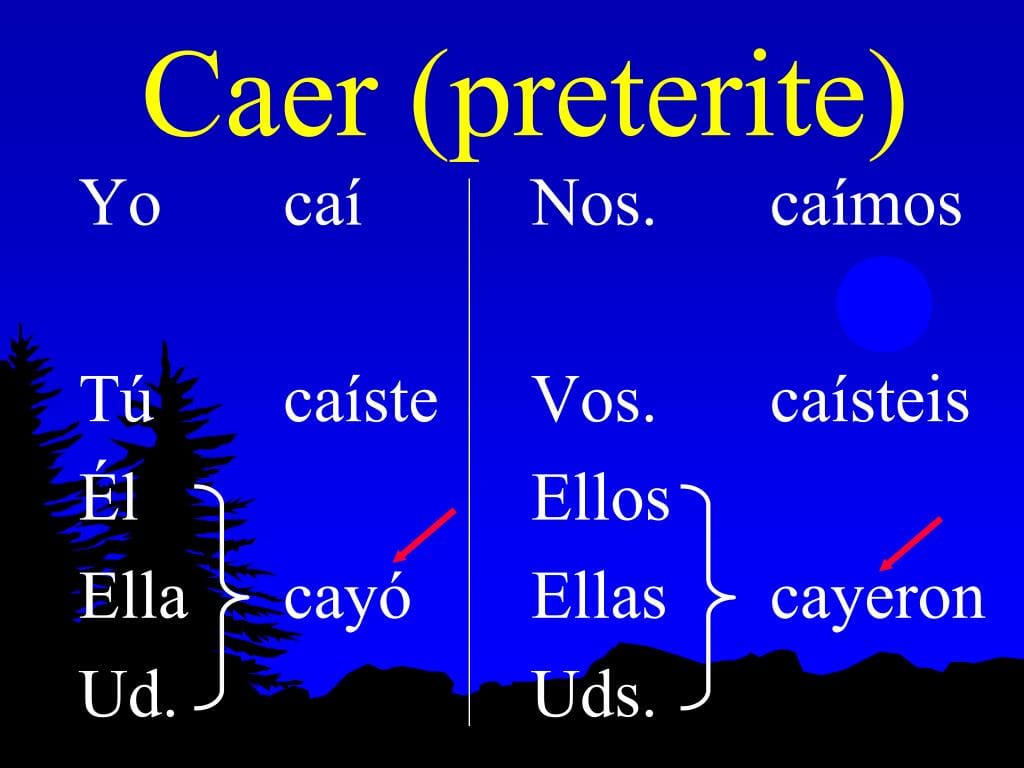Mastering the preterite tense of caer, meaning “to fall,” is essential for accurately describing past actions in Spanish. This comprehensive guide provides clear explanations, practical examples, and interactive exercises to help you confidently use caer in the preterite.
Understanding the Caer Preterite
The preterite tense describes completed actions in the past. Caer is irregular in the preterite, meaning it doesn’t follow standard conjugation patterns. This can make it tricky for learners, but don’t worry! With practice and the right guidance, you’ll be using it like a pro in no time.
Caer Preterite Conjugation Table
| Pronoun | Preterite Conjugation | Example Sentence | Translation |
|---|---|---|---|
| Yo | caí | Ayer, yo caí de la escalera. | Yesterday, I fell down the stairs. |
| Tú | caíste | ¿Caíste en la trampa? | Did you fall into the trap? |
| Él/Ella/Usted | cayó | El niño cayó al charco. | The boy fell into the puddle. |
| Nosotros/Nosotras | caímos | Nosotros caímos en la nieve. | We fell in the snow. |
| Vosotros/Vosotras | caísteis | ¿Caísteis del avión? (Less common in Latin America) | Did you all fall from the plane? |
| Ellos/Ellas/Ustedes | cayeron | Mis amigos cayeron de la montaña. | My friends fell from the mountain. |
For more information, check out the caer Preterite Conjugation Table.
Key Features of the Caer Preterite
- Irregularity: The stem changes from ca- to cay- in most forms. This stem change, along with the accent marks, is a hallmark of irregular verbs in the preterite.
- Accentuation: Note the accent mark on the ‘í’ in caí, caíste, caímos, and caísteis. This distinguishes these forms from other words and is crucial for correct pronunciation.
- Pronunciation: Pay close attention to the pronunciation of each form. The accent marks alter the stress and vowel sounds. Listening to native speakers can be invaluable for mastering the nuances of pronunciation.
Avoiding Common Mistakes with Caer
One common pitfall is confusing the preterite with the imperfect tense. Remember, the preterite is for completed actions, while the imperfect describes ongoing or habitual past actions. For example, caí (I fell) refers to a single, completed fall, whereas me caía (I used to fall/I was falling) describes a repeated action or an action in progress.
Another frequent error is misplacing or omitting the accent marks. These accents are essential for correct pronunciation and meaning, so be sure to include them.
Practicing the Caer Preterite
The best way to solidify your understanding is through practice. Try creating your own sentences using the caer preterite in various contexts. Visualize scenarios where someone might fall, literally or figuratively (e.g., falling in love). Online resources and workbooks with preterite tense exercises can also be beneficial for drilling the conjugations.
Exploring the Nuances of Caerse
Caerse, the reflexive form of caer, means “to fall down” or “to fall over,” emphasizing the action on oneself. It also appears in idiomatic expressions. Mastering caerse adds depth to your Spanish communication.
Caerse Preterite Conjugation Table
| Pronoun | Conjugation | Example Sentence | Translation |
|---|---|---|---|
| Yo | me caí | Ayer me caí de la bicicleta. | Yesterday, I fell off my bike. |
| Tú | te caíste | ¿Te caíste en la calle? | Did you fall in the street? |
| Él/Ella/Usted | se cayó | El niño se cayó del árbol. | The boy fell from the tree. |
| Nosotros/as | nos caímos | Nos caímos en el hielo. | We fell on the ice. |
| Vosotros/as | os caísteis | ¿Os caísteis de la montaña? | Did you all fall from the mountain? |
| Ellos/Ellas/Ustedes | se cayeron | Los estudiantes se cayeron en el patio. | The students fell in the playground. |
Idiomatic Expressions with Caer
Caer features in several idiomatic expressions:
- Caer bien/mal: To make a good/bad impression. For example, Me caíste bien** (I liked you/You made a good impression on me). These expressions are common in everyday conversation, so learning them will enhance your fluency. Some linguists suggest these idioms may originate from the concept of someone “falling” into favor or disfavor, although ongoing research explores their precise etymological roots.
Conjugating Caer Mal in the Preterite
Caer mal, meaning “to dislike” or “to not like someone,” uses the same preterite conjugations of caer with the addition of reflexive pronouns:
| Pronoun | Caer Mal (Preterite) | Example |
|---|---|---|
| Yo | Me caí mal | (Esa persona) me caí mal** (I disliked that person) |
| Tú | Te caíste mal | (Ese político) te caíste mal** (You disliked that politician) |
| Él/Ella/Usted | Se cayó mal | (El nuevo vecino) se cayó mal** (He/She disliked the new neighbor) |
| Nosotros/as | Nos caímos mal | (Esas ideas) nos caímos mal** (We disliked those ideas) |
| Vosotros/as | Os caísteis mal | (Esas costumbres) os caísteis mal** (You all disliked those customs) |
| Ellos/Ellas/Ustedes | Se cayeron mal | (Las nuevas reglas) se cayeron mal** (They/You all disliked the new rules) |
While grammatically correct, caer mal can sound blunt. In formal settings, consider using softer alternatives like no me cae bien (I don’t like him/her).
Beyond the Preterite: A Glimpse into the Imperfect Subjunctive
As you progress in your Spanish learning journey, you’ll likely encounter the imperfect subjunctive of caer. This mood expresses hypothetical or contrary-to-fact past situations and also utilizes the cay- stem. While beyond the scope of this guide focusing on the preterite, it’s helpful to be aware of this other tense.
By understanding the preterite conjugations of caer and caerse, recognizing common errors, and practicing regularly, you’ll considerably improve your ability to express past actions and idiomatic expressions effectively in Spanish. Don’t be afraid to make mistakes; it’s part of the process. Keep practicing, and soon, caer will be second nature to you.
- Unlock Elemental 2 Secrets: Actionable Insights Now - April 2, 2025
- Lot’s Wife’s Name: Unveiling the Mystery of Sodom’s Fall - April 2, 2025
- Photocell Sensors: A Complete Guide for Selection and Implementation - April 2, 2025
















